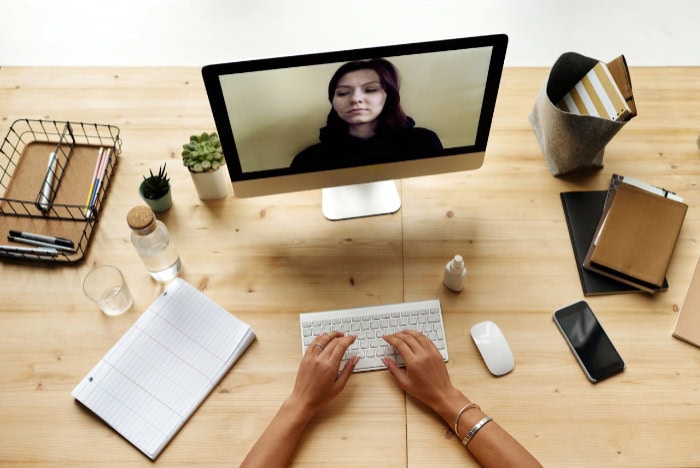How to Stay Productive While Working from Home

Remote work has transformed how millions of people approach their daily jobs, offering greater flexibility and eliminating long commutes. While working from home can be a dream for many, it also comes with its fair share of challenges.
Distractions abound, boundaries between personal and professional life can blur, and staying on task often requires more deliberate effort than in a traditional office setting.
However, with some thoughtful adjustments, it's entirely possible to maintain and even boost productivity in a home environment.
Creating a Productive Home Office Environment
Working from home can blur the lines between personal comfort and professional focus, which is why setting up a productive home office environment is crucial. A well-thought-out workspace can improve concentration, reduce stress, and help you stay organized throughout the day.
Designating a Dedicated Workspace
A dedicated workspace can dramatically improve your ability to focus. It helps create a mental boundary between “work mode” and “home mode,” signaling to your brain that this is where work gets done.
Ideally, this space should be separate from areas used for relaxation, such as your bed or living room couch, as mixing workspaces with personal spaces can make it harder to disengage at the end of the day.
If you have the luxury of a spare room, converting it into a home office can be a game-changer. However, if space is limited, even a designated corner of a room will suffice.
The important thing is to have a consistent space where work takes place. It can be as simple as setting up a desk in a quiet nook or using a folding table in the same location each day.
Consistency is the goal, as it helps train your mind to associate that space with productivity.
Ergonomics and Comfort
While it’s tempting to work from the comfort of your couch or bed, poor ergonomics can lead to long-term discomfort and health issues, such as back pain or repetitive strain injuries.
Investing in ergonomic furniture will not only enhance comfort but also prevent physical strain over time.
A proper desk and chair set-up with good lumbar support can make all the difference in maintaining your posture during the day.
Make sure your chair allows you to sit with your feet flat on the floor, and your desk height should keep your forearms parallel to the ground when typing. The top of your computer screen should be at eye level to avoid neck strain.
Additionally, good lighting is essential. Natural light is ideal, but if that’s not available, consider using a desk lamp with adjustable brightness to reduce eye strain.
Minimizing Distractions
Distractions are one of the biggest challenges when working from home. Household noises, family members, or even the temptation of nearby entertainment can easily derail your focus.
To minimize distractions, start by choosing a space that’s naturally quiet. If that’s not possible, noise-canceling headphones can be a lifesaver, especially if you're sharing your home with others or live near a busy street.
Visual distractions can also be challenging. Keeping your workspace clutter-free is a simple but effective way to stay focused.
A clean desk not only looks more professional but also reduces the mental clutter that can accumulate when surrounded by unnecessary items. Store personal items, papers, and other non-essential objects out of sight to maintain a clear, focused environment.
Mastering Time Management

Managing time effectively is one of the most critical aspects of staying productive while working from home. Without the structure of a traditional office, it’s easy to fall into the trap of working irregular hours or letting tasks drag on longer than necessary.
To maintain a high level of productivity, it's essential to create a solid framework for how you spend your time during the day.
Establishing a Routine
One of the best ways to ensure consistency in your work-from-home schedule is by establishing a daily routine. While working remotely gives you more flexibility, it’s important to maintain a structured schedule that mimics a traditional office environment.
Starting and ending work at the same time each day creates a rhythm that helps your brain transition into “work mode” and, just as importantly, into “off work mode” at the end of the day.
Begin your day with a morning routine that prepares you mentally for work. For example, try waking up at the same time every morning, having breakfast, and getting dressed as if you were going to the office.
This creates a sense of normalcy and cues your brain that it’s time to get things done. Similarly, having a consistent end-of-day routine will help you transition back to personal time, preventing work from bleeding into your evenings.
In addition, structuring your workday with regular hours helps communicate your availability to both your colleagues and family members, making it easier to set boundaries and avoid interruptions.
Time-Blocking and Prioritization
Even with a set routine, it’s easy to get overwhelmed by the number of tasks on your to-do list. This is where time-blocking and task prioritization come into play.
Time-blocking is a simple but effective technique where you divide your day into chunks of time dedicated to specific tasks.
By assigning certain hours to specific activities, you can stay focused on one task at a time, reducing the mental fatigue that comes from multitasking.
For instance, you might block out two hours in the morning to work on a report, followed by an hour for emails, and another block of time in the afternoon for meetings.
The Pomodoro Technique is a popular time-blocking method where you work in focused intervals (usually 25 minutes) followed by a short break.
This not only improves concentration but also ensures you’re taking breaks to recharge.
Prioritization is equally important. Identify the most important tasks at the start of each day and tackle them first.
This is often referred to as “eat the frog,” a concept that encourages you to complete the most challenging or essential task first, so the rest of your day feels more manageable.
Using tools like to-do lists or apps that categorize tasks by urgency can help keep you on track and ensure you’re focusing on what matters most.
Breaks and Downtime
It may seem counterintuitive, but taking regular breaks is one of the most effective ways to maintain productivity throughout the day. Working for extended periods without rest can lead to burnout, decreased focus, and slower progress.
Scheduling short but frequent breaks can help you stay sharp and energized.
A good rule of thumb is to take a 5-10 minute break for every hour of work. During these breaks, step away from your desk—go for a short walk, stretch, or do something unrelated to work.
This helps reset your mind, allowing you to return to your tasks with renewed focus.
Beyond short breaks, it’s also important to schedule longer downtime during the day. A proper lunch break and a mid-afternoon pause can prevent fatigue from setting in.
The goal is to avoid working in a continuous, unbroken stretch that drains your mental and physical energy. By incorporating regular pauses, you’ll find that you’re more productive, less stressed, and able to maintain a higher level of focus throughout your workday.
Setting Boundaries Between Work and Personal Life

One of the most significant challenges of working from home is maintaining a clear distinction between professional responsibilities and personal life. Without the physical separation of an office, work can easily spill over into personal time, leading to stress and reduced productivity.
Establishing clear boundaries helps preserve balance and ensures that both work and personal needs are met without one overshadowing the other.
Defining Clear Work Hours
Setting specific work hours is crucial for minimizing interruptions and maintaining focus throughout the day. When working from home, it can be tempting to let your schedule become flexible, but this often leads to inconsistent productivity and confusion among family or housemates about when you’re available.
To prevent disruptions, define clear start and end times for your workday and communicate them to those you live with. This could mean posting your work hours on the fridge or having a quick conversation with your family about when you’ll be working.
The goal is to set expectations, so those around you understand that, during these hours, you are in “work mode” and should not be disturbed unless absolutely necessary.
Additionally, keeping consistent hours helps you stay on track and avoid working late into the night. It’s all too easy to let work bleed into personal time when there’s no clear boundary, but adhering to a schedule creates a sense of structure that benefits both your professional and personal life.
Creating Mental Separation
While it’s important to have physical boundaries, creating mental separation between work and personal life is equally essential. This is especially true when your workspace is part of your home environment.
One effective strategy is developing end-of-day rituals that signal to your brain that the workday is over.
For example, you could close your laptop, clear your desk, and engage in a brief activity that marks the transition from work to personal time. Some people enjoy taking a short walk to simulate the commute they would normally have when leaving an office—this helps create a mental shift.
Others might choose to change into more casual clothes, listen to music, or spend a few minutes unwinding in a different part of the house.
These small habits can have a significant impact on how you perceive your work-life balance. By creating mental cues that help you switch out of “work mode,” you prevent the stress of the workday from spilling over into your personal time.
Managing Household Responsibilities
Balancing household chores and caregiving duties while working from home can be tricky, as the proximity to these tasks can make them harder to ignore.
However, blending these responsibilities with work without a plan can lead to decreased productivity and added stress.
To manage this, schedule specific times to handle household duties. For example, you might dedicate a few minutes during your lunch break to do a quick chore or set aside time after work to attend to household needs.
The key is to avoid multitasking between work and personal responsibilities. Attempting to answer work emails while folding laundry, for instance, divides your attention and reduces the efficiency of both tasks.
If you have caregiving duties, such as looking after children, it’s important to establish routines that work for everyone. This might involve coordinating with a partner or seeking help during critical work hours.
Creating a structured plan ensures that you can focus on work during designated times and dedicate your full attention to household needs outside of those hours, maintaining a healthy balance between the two.
Leveraging Technology for Efficiency

Working from home often requires a greater reliance on technology to maintain productivity and collaboration. Fortunately, a variety of tools are available to streamline workflows, improve communication, and automate repetitive tasks.
When used effectively, these technologies can help you stay organized, manage your time more efficiently, and maintain seamless connections with your team.
Productivity Tools
Effective task management is essential for staying on top of your workload, especially when juggling multiple projects or collaborating with a team.
Productivity tools like Trello, Asana, and Slack are designed to help you organize tasks, set deadlines, and track progress in a clear, visual format.
Trello, for example, uses boards and cards to break down tasks into manageable steps. Each card can represent a task, which can be moved from one stage to the next—such as “To Do,” “In Progress,” and “Completed”—providing a clear overview of what’s been done and what remains.
This method is especially helpful for visual thinkers who need to see their tasks laid out in front of them.
Asana is another popular project management tool, ideal for teams that need to collaborate on complex projects. It allows you to assign tasks to specific individuals, set deadlines, and track progress in real-time.
The ability to attach files, leave comments, and integrate with other tools like Google Drive makes it a comprehensive solution for managing team projects remotely.
Slack, on the other hand, is a communication tool that simplifies team collaboration. It allows for instant messaging, file sharing, and the creation of dedicated channels for different teams or projects.
This reduces the need for long email threads and helps keep conversations organized, making it easier to track important information.
Automation and Time Tracking
Automation can significantly reduce the amount of time spent on repetitive tasks, allowing you to focus on more meaningful work. Tools like Zapier and IFTTT (If This Then That) are designed to automate workflows by connecting different apps and services.
For instance, you could set up a workflow that automatically saves email attachments to a cloud storage service like Google Drive or sends you a daily summary of tasks from your project management app.
These automations operate in the background, quietly simplifying your workload without you having to lift a finger. The fewer manual tasks you have to handle, the more time you can dedicate to work that requires focus and creativity.
Time tracking is equally important for monitoring how you’re spending your time and identifying areas where adjustments can be made. Apps like Toggl allow you to track the time spent on individual tasks or projects, providing insights into your daily work habits.
These tools can help you become more aware of how long certain tasks take, allowing you to optimize your schedule and improve time management.
By tracking your time, you can also avoid overworking, as the data can highlight when you’re spending too much time on specific tasks.
This is particularly useful for freelancers or workers who need to bill clients for hours worked, ensuring that time is accounted for accurately.
Communication Platforms
Staying connected with colleagues while working remotely is essential for maintaining collaboration and ensuring projects move forward smoothly. In this area, video conferencing tools like Zoom and Microsoft Teams have become indispensable.
These platforms offer high-quality video and audio, making virtual meetings feel more personal and effective.
Zoom is widely used for its simplicity and reliability, enabling teams to hold meetings, share screens, and record sessions for future reference. The ability to host large meetings with multiple participants makes it a strong choice for companies of all sizes.
For smaller teams, Zoom’s breakout rooms feature allows for more focused discussions during larger group meetings.
Microsoft Teams combines video conferencing with robust collaboration features, including file sharing, chat functionality, and integration with other Microsoft products like Word and Excel. This makes it particularly useful for teams that rely heavily on Microsoft Office tools.
Instant messaging platforms like Slack or Microsoft Teams’ chat feature can also be used to facilitate quick communication throughout the day. These allow for real-time updates, reducing the need for constant email checking and ensuring that important information can be shared and discussed promptly.
Whether you’re working on a quick project or need to touch base with a colleague, these platforms help maintain the flow of communication without the delays often associated with emails.
Maintaining Well-being and Avoiding Burnout

While working from home offers numerous benefits, it also presents unique challenges to maintaining both physical and mental well-being.
Without the natural breaks and social interactions of an office environment, it can be easy to fall into unhealthy habits, such as working long hours without rest or neglecting your physical health.
Prioritizing your well-being is crucial for sustaining productivity over the long term and preventing burnout.
Physical Health
Sitting at a desk for long periods can lead to various health problems, particularly if you’re not taking breaks to move around. Incorporating physical activity into your daily routine is essential to counteract the effects of a sedentary lifestyle.
Even small movements can make a big difference in how you feel throughout the day.
One simple yet effective way to stay active is by taking short walking breaks. Stepping away from your workspace for just 5-10 minutes every hour can help improve circulation, reduce back pain, and give your eyes a rest from screen time.
If walking isn’t possible, consider stretching exercises to relieve muscle tension. Stretching your arms, shoulders, and back can help combat the stiffness that comes from sitting in one position for too long.
Additionally, setting reminders to stand up and move throughout the day can help you stay mindful of your activity levels.
Some people find it helpful to use a standing desk for part of the day, which allows them to switch between sitting and standing while working.
The goal is to break up long periods of inactivity so that you remain physically engaged, even while working from home.
Mental Health Practices
Remote work can blur the boundaries between personal and professional life, leading to stress and, in some cases, burnout. To protect your mental health, it’s important to incorporate practices that help you manage stress and stay grounded.
Mindfulness and meditation are two effective techniques that can be easily integrated into your day, even if you’re new to these practices.
Mindfulness involves focusing on the present moment and observing your thoughts without judgment. This can be as simple as taking a few minutes to breathe deeply or practicing a short meditation session to clear your mind.
Apps like Headspace or Calm offer guided meditation sessions that can help you develop this habit.
Another important aspect of mental well-being is setting realistic goals. It’s easy to feel overwhelmed when faced with a long list of tasks, but breaking them down into smaller, manageable steps can make them feel less daunting.
Set aside time at the beginning of each day to prioritize tasks and focus on what’s most important. This approach not only helps you stay organized but also reduces stress by making your workload feel more achievable.
Don’t forget to give yourself permission to take breaks when needed. Working continuously without rest can lead to mental fatigue, so it’s important to step away from your desk periodically to recharge.
Whether it’s a quick walk, a cup of tea, or a few minutes of quiet time, small breaks can have a big impact on your overall mental health.
Social Interaction
One of the less obvious challenges of working from home is the lack of social interaction, which can lead to feelings of isolation.
In an office setting, casual conversations with colleagues provide a sense of connection and camaraderie, but these interactions can be harder to come by when working remotely.
To combat isolation, make it a point to schedule regular virtual check-ins with colleagues. These don’t have to be formal meetings; even a quick video call to catch up or share updates can help maintain a sense of connection.
Teams that stay in touch regularly tend to feel more cohesive, which can boost morale and productivity.
If your work environment doesn’t naturally lend itself to frequent social interaction, consider joining online communities or professional groups related to your field.
Many remote workers find support and engagement through platforms like LinkedIn, Slack communities, or industry-specific forums.
These virtual spaces provide a way to share experiences, ask questions, and stay connected with others who understand the unique challenges of remote work.
Balancing social interaction with focused work time is important, as it helps you feel more connected to others while still maintaining productivity.
Conclusion
Staying productive while working from home requires a thoughtful approach to both your work environment and your personal well-being. Designing a dedicated workspace, mastering time management techniques, and setting clear boundaries between work and personal life all help create a structure that supports focus and efficiency.
Leveraging technology can further streamline your tasks, while maintaining physical health, mental well-being, and social connections ensures you avoid burnout. By combining these strategies, remote work can become not just manageable, but a fulfilling and sustainable way to achieve your professional goals.


